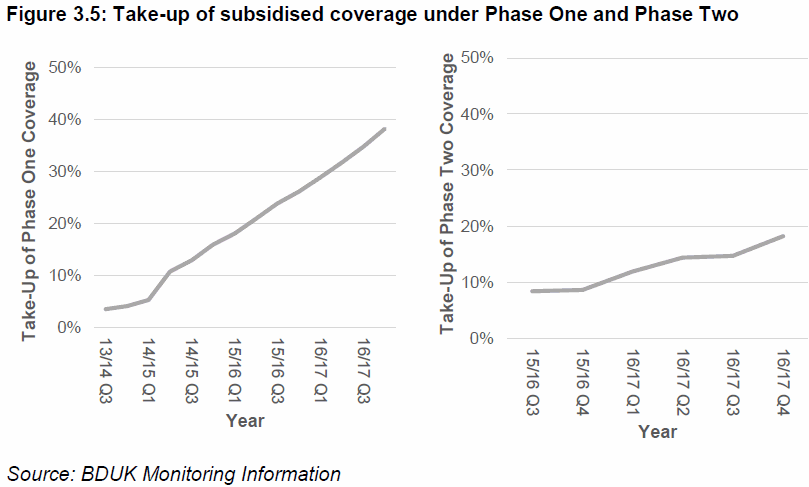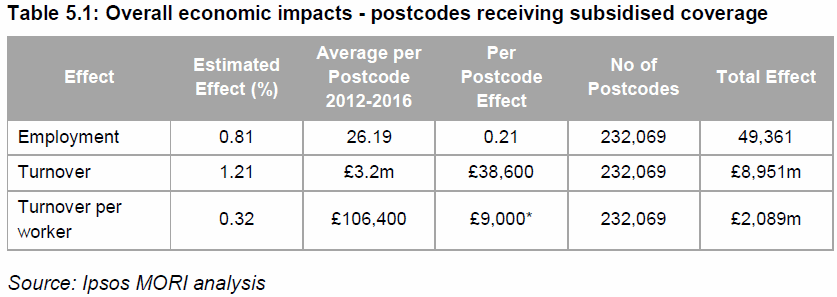Gov Says UK Superfast Broadband Project Delivers £9bn Biz Boost UPDATE
The Government have today estimated that their £1.6bn+ Broadband Delivery UK project, which with the help of operators like BT (Openreach) and Gigaclear has extended fixed “superfast broadband” (24Mbps+) ISP networks to cover 95%+ of UK premises, also delivered a £9bn boost to national business turnover.
Firstly, it’s important to clarify that the commercial market had already done most of the leg work for this. Overall commercial operators, including big names like Virgin Media, Openreach and lots of smaller players, have managed to extend the coverage of superfast broadband connectivity to around 76% of UK homes and businesses.
By comparison the BDUK scheme has largely focused its state aid supported gap funding model upon the final 24% of premises, which are usually rural or sub-urban areas that commercial operators have found to be unviable (i.e. market failure – too expensive to reach without public investment to help co-fund the roll-out).
Advertisement
Overall the BDUK investment (c.£700m from the government and c.£900m+ from other local bodies) has thus resulted in superfast broadband networks being deployed to reach almost 5 million extra UK premises. The programme is on-going and could even cover around 98% of premises by the end of 2020, while the planned 10Mbps+ USO is expected to handle that final 1-2%.
Business Benefits
Accurately gauging the economic impact of deploying faster broadband connectivity is of course notoriously difficult, not least since most businesses and consumers won’t be starting from a point of zero connectivity (the bulk will have upgraded from a slower to faster broadband link). As such any study that claims to show a huge economic boost should be taken with a pinch of salt.
Nevertheless few disagree that there does tend to be a positive relationship between broadband investment and growth, with today’s research boldly declaring that “areas covered by the Government’s rollout of superfast broadband have seen a combined £9 billion increase in turnover since the boost to their broadband speed.” The benefit to businesses is certainly a lot clearer than for residential households (see below).
All of this stems from a new “independent assessment” of the impact that the BDUK supported rollout has had in its first years (2012-2016), which was produced for DCMS by Ipsos MORI, Simetrica, George Barrett and Dr. Pantelis Koutroumpis (Dr. Pantelis also did this related study for Ofcom).
Advertisement
Key Findings
* £9 billion surge in turnover for businesses benefitting from the faster connections now available.
* £690 million net increase in Gross Value Added to the UK economy.
* A reduction of almost 9000 individuals claiming jobseekers allowance, as well as a reduction in long term claimants by 2,500 in programme areas, accompanied by the creation of 49,000 local jobs.
* Programme has delivered £12.28 benefit for businesses for every £1 invested by the Government and local authorities. However we noted that the estimated Benefit to Cost Ratio (BCR) of residential coverage falls from £12.28 (businesses) to just £1.18 for households (it’s stated that households appear to have less intensive bandwidth requirements and derive smaller benefits from consuming superfast service).
* Strong indication that high take up rates of Government’s superfast programme have encouraged telecommunications industry to expand their own commercial broadband projects.
We should point out that a mix of savings and gainshare (i.e. clawback due to high take-up by consumers in BDUK upgraded areas) will mean that c.£750m of the investment could be returned (here and here) and thus reinvested to help reach the aforementioned c.98% coverage aspiration (going from 95% to 98% should add another c.1 million premises).
Contracts vary but clawback tends to kick in when take-up starts going beyond the 20% mark and the BDUK programme is currently running at an impressive 45%, which is said to be “more than double the expected rate“. The table below shows how take-up has grown (Phase One reflects the original 90% superfast coverage target, while Phase Two reflects contracts for the recently completed 95% coverage goal).

Back in 2015 the National Audit Office (NAO) actually noted that the very first BDUK contracts seemed to only be predicting initial take-up of just 1-2% (here).
Margot James MP, UK Minister for Digital, said:
“Our rollout of superfast broadband across the UK has been the most challenging infrastructure project in a generation but is one of our greatest successes. We are reaching thousands more homes and businesses every week, that can now reap the clear and tangible benefits that superfast broadband provides. We are helping to ensure the downfall of the digital divide.”
Clive Selley, Openreach CEO, said:
“It is great to see businesses across the UK reaping the benefits of faster broadband speeds and I’m proud of the leading role that Openreach has played in helping to deliver the Government’s rollout of superfast broadband – one of Britain’s great engineering achievements. We’ve also recently introduced a raft of lower wholesale prices to help drive higher take-up of faster fibre services which will help to further fuel the boost to the UK economy.”
At this point it’s customary for some to criticise the decision to go with a Fibre-to-the-Cabinet (FTTC / VDSL2) dominated deployment under BDUK instead of a more future proof FTTP one. But it’s worth considering that FTTP would have taken many years longer to roll-out and wouldn’t have reached anything like the same level of coverage with such a comparatively small investment (FTTP needs tens of billions of pounds).
Advertisement
Equally bringing FTTC to all those new communities also helps FTTP by building the core optical fibre cables much closer to homes and businesses, which will make it easier for operators’ to expand out via FTTP in the future. This will be crucial given the government’s new aspiration to cover the entire country with full fibre networks by 2033 (at present no significant new public money has been set aside to fund this).
UPDATE 10:08am
The full report is now online here and we also have some comments to add.
Tim Breitmeyer, CLA President, said:
“This research vindicates the CLA’s position on the value that superfast broadband can bring to our rural economy. Despite the progress made on the roll-out of superfast broadband, the research also highlights the disparity between broadband in urban areas in comparison to rural areas.
Together with broadband, 4G mobile coverage is essential for services in 21st century Britain, but rural areas are not able to participate in the digital revolution as fully as in urban areas. We want mobile phone operators held to account to deliver universal rural 4G Digital infrastructure which is vital in making rural villages, farms and businesses sustainable by acting as a catalyst for economic growth and job creation.”
Jeremy Chelot, CEO of Community Fibre, said:
“The UK is in desperate need of high quality broadband infrastructure to remain competitive and many smaller and more innovative companies are in a great position to provide this. It is now up to the Government to support and encourage their growth. Easing the ability for those building true full fibre networks to sign new wayleaves would undoubtedly prove to be a step in the right direction.
Furthermore, a clear, legally enforceable definition of full-fibre would make clear to the public and building managers that copper connections do not constitute true full-fibre and that their homes are not fully future-proofed. True full-fibre connections are vital to fast and reliable internet connectivity; but effectively communicating this to those who make decisions about broadband connections should be a starting-point for policy makers.
With concerns over the UK’s broadband competitiveness increasingly becoming a political issue, especially within the context of a hard Brexit, the current government’s plans to deliver “full-fibre” by 2033 should focus on adequate investment, clear definitions and a commitment to delivering genuine full-fibre for all.”
Evan Wienburg, CEO of TrueSpeed, said:
“Today’s research demonstrates the huge benefits that broadband can have to UK businesses, but let’s not get carried away. The majority of the current infrastructure remains a makeweight solution that won’t support future connectivity needs – it’s the full-fibre network rollout stats that should set the benchmark for success.
The Government is on the right track, but in the South West, which has the lowest superfast coverage in England, there are still many underserved communities in which local businesses cannot access cloud-based tools, where home-working is a non-starter, and where growing numbers of urban commuters spend their mornings clogging up the roads rather than driving UK productivity. In the next, game-changing evolution of our infrastructure, we cannot afford to let these communities slip further behind the rest of the country.”
UPDATE 5:54pm
A quote from wireless ISP Airband.
Red Peel, Founder and Director of Airband, said:
“Today’s report shows the Government’s investment in rural broadband is starting to have an impact but there remains a lot to be done, to ensure that roll-out of superfast programmes is as swift as possible.
The number one problem is the way that councils manage their highways agencies, – often expensive and time-consuming permits are needed for fibre roll-out. Permits can sometimes require a six-month notification window. This is causing a lot of frustration in the industry, and is significantly pushing up the cost of deploying fibre, and almost negating the cost benefits the government is offering.”
Mark is a professional technology writer, IT consultant and computer engineer from Dorset (England), he also founded ISPreview in 1999 and enjoys analysing the latest telecoms and broadband developments. Find me on X (Twitter), Mastodon, Facebook, BlueSky, Threads.net and Linkedin.
« BT and Axione Lock Horns Over Scotland’s R100 Broadband Plan




















































Comments are closed